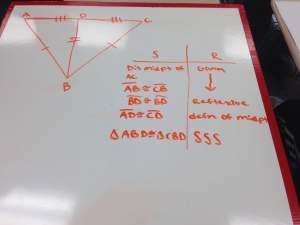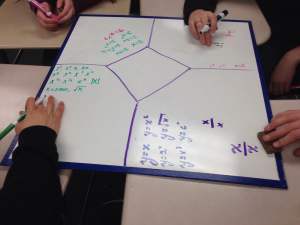Collaborative Whiteboarding
Karen Hyers
Tartan High School
MCTM VP At-Large
I am always looking for new ways to get my students communicating mathematics and working together. A session during an NCTM Conference included an activity using personal whiteboards. My students loved the activity and I was captivated by the possibilities. If you are looking for a fairly inexpensive tool to get your students engaged, consider whiteboarding.
 I have two sets of student whiteboards in my classroom. I use them for different purposes based on the intended outcomes and activity. My group boards measure 2’ x 2’. They were cut from a 4’ x 8’ sheet of tile board at a local building supply store. Total cost $16 for 8 boards. My individual use boards are 9” x 12” double-sided (blank and grid). The class set cost about $100 five years ago.
I have two sets of student whiteboards in my classroom. I use them for different purposes based on the intended outcomes and activity. My group boards measure 2’ x 2’. They were cut from a 4’ x 8’ sheet of tile board at a local building supply store. Total cost $16 for 8 boards. My individual use boards are 9” x 12” double-sided (blank and grid). The class set cost about $100 five years ago.
My students are more willing to explore and try new things on whiteboards. The advantage over chart paper (or even their notebooks) is that they can easily erase their work and make changes. They stay active in class because there is a tangible result to produce. I can hold everyone accountable by giving each student a different colored marker or using only one marker and rotating group recorders. It helps me to do formative assessment and quickly see which groups need more support, which ones are ready to move on, or if the whole class has a major misconception.
Sample group activities:
 Brainstorming: section the boards off so that each student has a space to write (I use groups of 4) with a center section for a final answer, if appropriate. For example, working with limits and end behavior, individually brainstorm functions with infinite end behavior (i.e. f(x) increases without bound as x approaches infinity). Then, as a group, combine two functions so that their difference (or sum or quotient) has a limit of 2 (or 0 or …).
Brainstorming: section the boards off so that each student has a space to write (I use groups of 4) with a center section for a final answer, if appropriate. For example, working with limits and end behavior, individually brainstorm functions with infinite end behavior (i.e. f(x) increases without bound as x approaches infinity). Then, as a group, combine two functions so that their difference (or sum or quotient) has a limit of 2 (or 0 or …).
- Class presentations: groups prepare a solution (or partial solution) to a specific problem. I put the potential problems on post-its. Usually, I let the students choose their problem (and have a couple of extra options so everyone has a choice). Or I choose the problem for each group to differentiate the activity. The groups can present their problems to the whole class or the class can do a gallery walk.
- How did they get that?: Section off the board into quarters labelled A, B, C, D. Using multiple choice practice questions for the MCA’s, ACT or AP test, find the error that produces the solution that would lead to each option.
- Review day: Assign each group a different section or topic and have them prepare a summary statement, sample question, or margin question (Cornell notes). Have the class do a gallery walk and take pictures on their phone of ideas they need to study.
Individual or partner activities:
- Partner graphs 1: One person uses the blank side to work with the equation or build a table. Their partner uses another board on the grid side to make the graph. I use this with introducing new functions in Algebra 2.
- Partner graphs 2: A pair of students sit back-to-back with one looking at the SMART Board. The first person describes the graph (or geometric figure) to their partner using math vocabulary. The partner attempts to reproduce the graph. Variations include a Taboo version where certain words/concepts cannot be used or opposite Taboo where only certain words/concepts can be used.
- Low tech clickers: Students work a series of problems individually or in pairs and display their final answers.
If you are looking for more ideas on using whiteboards, two resources that I like are:
Kelly O’Shea’s blog: https://kellyoshea.wordpress.com/whiteboarding/
Frank Noschese: https://fnoschese.wordpress.com/2010/08/06/the-2-interactive-whiteboard/
How do you use whiteboards in your classroom? Continue the conversation in the comments or on Twitter (I am @keyhyers).


Thanks, Karen, for the great white boarding ideas. I never thought of a 2′ X 2′ group board!!!!!
You write good:-)
Judy